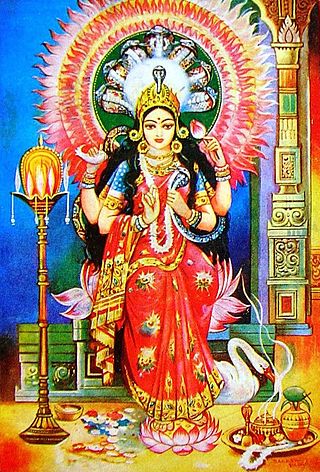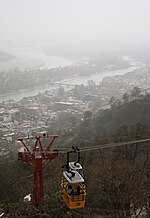
Haridwar is a city and municipal corporation in the Haridwar district of Uttarakhand, India. With a population of 228,832 in 2011, it is the second-largest city in the state and the largest in the district.

The Shakta pithas, Shakti pithas or Sati pithas are significant shrines and pilgrimage destinations in Shaktism, the mother goddess denomination in Hinduism. The shrines are dedicated to various forms of Adi Shakti. Various Puranas such as Srimad Devi Bhagavatam state the existence of a varying number of 51, 52, 64 and 108 Shakta pithas of which 18 are named as Astadasha Maha (major) in medieval Hindu texts.

Haridwar district, also spelled Hardwar, is part of Uttarakhand, India that lies in the Doab region, where people traditionally speak Khariboli. It is headquartered at Haridwar which is also its largest city. The district is ringed by the districts Dehradun in the north and east, Pauri Garhwal in the east and the Uttar Pradesh districts of Muzaffarnagar and Bijnor in the south and Saharanpur in the west.

Chintpurni is a small town in the Una district of Himachal Pradesh about 40 km north of Una, not far from the border with the Indian state of Punjab. The elevation is about 977 meters. It is home to the Maa Chintpurni Temple which is a major pilgrimage site as one of the Shakti Peethas in India. The Hindu genealogy registers at Chintpurni, Himachal Pradesh are kept here. North of Chintpurni are the western Himalayas. Chintpurni lies within the much lower Shiwalik range.
Kankhal is a small colony in Haridwar in the Haridwar district of Uttarakhand state in India.

Hinglaj is an important Hindu pilgrimage place in Balochistan, Pakistan and Kuldevi of many Rajput, Jat, Charan, Rajpurohits and other Hindu Communities of India. It is situated in Balochistan province about 250 km west-northwest of Karachi. The Shri Hinglaj Mata mandir which is the largest Hindu pilgrimage centre in Pakistan is located here.

In Hinduism, the yatra (pilgrimage) to the tirthas has special significance for earning the punya needed to attain the moksha (salvation) by performing the darśana, the parikrama (circumambulation), the yajna, the Dhyana, the puja (worship), the prarthana, the dakshina, the seva, the bhandara, etc. These sacred places are usually located on the banks of sacred waters, such as sacred rivers or their tributaries, the kundas, the ghats, or the stepwells, or the temple tanks.

Chandi Mandir is a Hindu temple dedicated to Chandi the goddess of power, near Chandigarh, located on NH-5 Chandigarh-Kalka highway in Panchkula city of Haryana state of India. It is about 15 km from the city of Chandigarh, which was named after the temple, and about 10 km away from the Mansa Devi Shrine. The temple is situated amidst beautiful surroundings and the backdrop of the Shivalik hills.

Kalighat Kali Temple is a Hindu temple in Kalighat, Kolkata, West Bengal, India, dedicated to the Hindu goddess Kali. It is one of the 51 Shakti Pithas in eastern India.

Manasa is a Hindu goddess of snakes. She is worshipped mainly in Bihar, Odisha, Bengal, Jharkhand, South Assam and other parts of northeastern India and in Uttarakhand, chiefly for the prevention and cure of snakebite, and also for fertility and prosperity. In Hinduism, Manasa is the sister of Shesha and Vasuki, king of Nāgas (serpents), and wife of sage Jaratkaru. She is the mother of the sage Astika. She is also known as Vishahari, Nityā (eternal) and Padmavati.

Mahavinayak Temple is a major pilgrimage center in Chandikhole in Jajpur district in the Indian state of Odisha. It is one of the oldest Ganesha temples in the state. Five gods - Shiva, Vishnu, Durga, Surya and Ganesha - are worshiped as one deity in a single Garbhagriha or sanctum sanctorum there.

Mata Mansa Devi is a Hindu temple dedicated to goddess Mansa Devi, a form of Shakti, in the Panchkula district of the Indian state of Haryana. The temple complex is spread of 100 acres (0.40 km2) of the Shivalik foothills in the village of Bilaspur, near Sector 13 of Chandigarh, and Panchkula, 10 km from Chandi Mandir, another noted Devi shrine in the region, both just outside Chandigarh.

Maya Devi Temple, Haridwar is a Hindu temple dedicated to goddess Maya in the holy city of Haridwar of Uttarakhand state in India. It is believed that the heart and navel of goddess Sati fell in the region where the temple stands today and thus it is sometimes referred to as a Shakti Peetha.

Chandi Devi Temple, Haridwar is a Hindu temple dedicated to Goddess Chandi Devi in the holy city of Haridwar in the Uttarakhand state of India. The temple is situated atop the Neel Parvat on the Eastern summit of the Sivalik Hills, the southernmost mountain chain of the Himalayas. Chandi Devi Temple was built in 1929 by Suchat Singh in his reign as the King of Kashmir. However, the main murti of Chandi Devi at the temple is said to have been installed in the 8th century by Adi Shankaracharya, one of the greatest priests of Hindu religion. The temple also known as Neel Parvat Teerth is one of the Panch Tirth located within Haridwar.

Chandika Sthan is a Hindu temple situated in Munger, in the India state of Bihar. It is one of the fifty-one Shakti Peethas, places of worship consecrated to the goddess Shakti. On the Northeast corner of Munger, Chandika Sthan is just two kilometers away from the Munger town. Being a Siddhi-Peetha, Chandika Sthan is considered to be one of the most sacred and sanctified temples, as important as the Kamakshya temple near Guwahati. Sati's left eye fell here and it is believed that those who worship here get rid of eye pain. It is one of the major Hindu pilgrimage centre in Ang Pradesh region of Bihar.
In religion and spirituality, a pilgrimage is a very long journey or search of great moral significance. Sometimes, it is a journey to a sacred area or shrine of importance to innate faith. Members of every major religion participate in pilgrimages. A person who makes such a journey is called a pilgrim.
Mata Mansa Devi is a Hindu temple of Mansa Devi, in Sikar district of Rajasthan state in India. The temple complex is spread over 100 acres (0.40 km2) in the Hasampur Hills foothills in village Hasampur, near Neem-Ka-Thana, and Sikar, 20 km from National Highway 8 (India) Kotputli, another noted Devi shrine in the region, both just outside Sikar.
Veerabhadra Temple is located on Devakuta Parvatham, a hillock on an islet amidst the Godavari River near Pattiseema in West Godavari, Andhra Pradesh. The temple is dedicated to Shiva and the namesake is Veerabhadra.
















